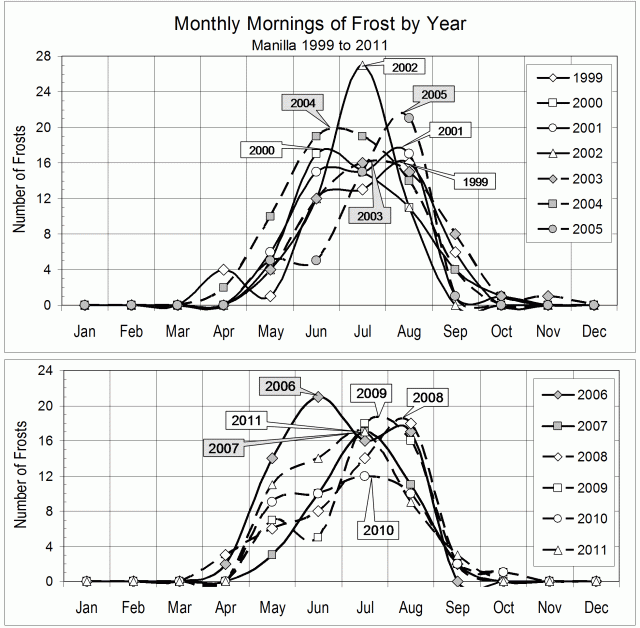I have a 13 year record that shows how frosty Manilla is, and how some years are frostier than others. My thermometer is on high ground, so people living where cold air collects will have had more frosts. However, my readings show changes from one time to another. As I do not have a thermometer in the grass, I have recorded a frost when my screen reading is below +2.2°.
There is a matching post for Manilla’s hot days.
Total frosts
The first graph shows the number of frosty mornings in each year. The most frosts were in the years 2004 (68) and 2006 (70); the fewest were in the years 2007 (43) and 2010 (44). The 13-year average is 54.
The graph also shows the number of mornings colder than zero, minus two, and minus four degrees. On the average, these occurred on 26, 7, and 1 mornings per year. For those colder than zero degrees, 2006 was again the frostiest, but 2002 was also very frosty. Counting only the most severe frosts (below minus two or minus four degrees) 2002 was the frostiest year. It had the coldest mornings: -5.1° on both the 2nd and 11th of July.
Frosty months
The second graph shows how most frosts come in the winter months, especially July, with some frosts in autumn, but few in spring and none in summer. Few come before Anzac Day (25th April) or after Labour Day (first Monday in October in NSW).
The graphs below show that each year was different. The drought year 2002 had the highest number of frosts in a single month: 27 in July – half of all frosts in that year. By contrast, the 70 frosts of 2006 were spread through the months of winter and autumn: there were more frosts in June and August than in July.
The peak number of frosty mornings did not always come in July. It came in June in 2000, 2004, and 2006, and in August in 1999, 2001, 2005, and 2008.
This article appeared in “The Manilla Express” for 3rd July 2012, and also as a “weatherzone” forum post dated 17th June 2012.
I have posted it on this blog in April 2014, but back-dated to 28th June 2012.
